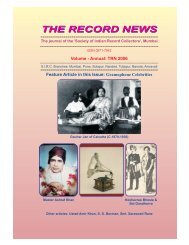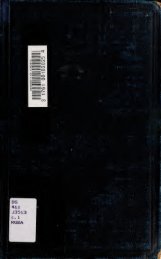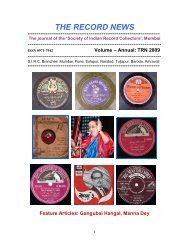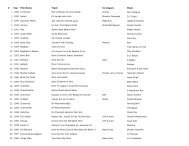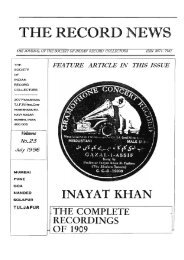THE RECORD NEWS - The Digital South Asia Library - University of ...
THE RECORD NEWS - The Digital South Asia Library - University of ...
THE RECORD NEWS - The Digital South Asia Library - University of ...
Create successful ePaper yourself
Turn your PDF publications into a flip-book with our unique Google optimized e-Paper software.
Gramophone Celebrities – 48<br />
Pandit Firoz Dastoor – (1919-2008)<br />
Pandit Firoz Dastur was born into a Parsi family to parents who had a deep love<br />
for music and poetry, especially Urdu writings. Quite interestingly, as a child, he<br />
started his career as a film actor. Firoz Dastur was a very pronounced name in<br />
the world <strong>of</strong> film playback, acting and radio broadcasting. Born in 1919, he made<br />
a very interesting switchover from rendering film music to actually training and<br />
eventually performing raga-based music. It was the elderly music-lovers from his<br />
father's culture club, who arranged for the young Firoz's training under<br />
Krishnarao D. Jaokar - a leading music teacher and disciple <strong>of</strong> Ustad Abdul<br />
Karim Khan <strong>of</strong> the Kirana gharana, who had also made HMV records with name<br />
– K. D. Jaokar. <strong>The</strong> renowned tabla player Kamuarao Mangeshkar was engaged<br />
to give the young student strict lessons in tala. It was when Pandit Dastur had to<br />
advance his training in music that it was recommended that he learn from the<br />
very renowned Pandit Sawai Gandharva. Talking about his tutelage under this<br />
renowned guru, Pandit Dastur today says that contrary to what most believe,<br />
Pandit Sawai Gandharva was not a harsh taskmaster. Instead, he was very<br />
thorough in his methods. While his training was impeccable he was rather<br />
lovable and approachable a personality. His initiation into formal training by this<br />
renowned teacher started rather unconventionally, with his learning <strong>of</strong> the raga<br />
Bhairavi. This raga is said to be a concluding raga in a classical performance in<br />
Hindustani music. However, it is also one which adequately gauges a student's<br />
vocal capacity. Pandit Dastur was asked to render a musical piece in raga<br />
Bhairavi and he very innocently rendered a film song. His teacher was rather<br />
impressed with this rendition and in Panditji's own words he had sufficiently<br />
passed his first music 'test'. It started a long period <strong>of</strong> learning wherein Pandit<br />
Dastur learnt several ragas, and perfected his sargams, boltaans and most<br />
importantly alaapi - a significant characteristic <strong>of</strong> Kirana Gayaki. Pandit Dastur is<br />
undoubtedly a brilliant exponent <strong>of</strong> the Kirana gayaki. More importantly he has<br />
also been a wonderful teacher to several students who have gone on to make<br />
their mark as performers and broadcast vocalists. Some <strong>of</strong> these include, Srikant<br />
Deshpande, (the grandson <strong>of</strong> Sawai Gandharva), Milind Chittal, Sudha Divekar<br />
and Achyut Abhyankar. Pandit Dastur has been awarded with several laurels for<br />
his contribution to Indian music. Among these include the Sangeet Natak<br />
Academy award for Hindustani Music in 1987, the Tansen Samman award <strong>of</strong> the<br />
Madhya Pradesh Government and an honorary doctorate <strong>of</strong> <strong>South</strong> Gujarat<br />
<strong>University</strong> <strong>of</strong> Surat in 1988, among many other prestigious awards. Today, this<br />
accomplished vocalist is a veteran octogenarian. He maintains a passion for<br />
reading books on philosophy and still performs at the annual Sawai Gandharva<br />
Music festival held in Pune city, as a mark <strong>of</strong> respect, honor and humility to his<br />
great guru.<br />
16



